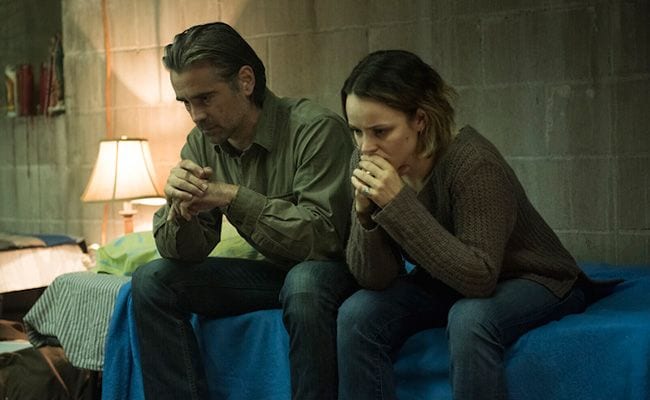
This season of True Detective maddens the viewer with its baroque inconsistency. Writer and creator Nic Pizzolatto has thus far created a slew of compelling characters, clichés, conveniences, complications, and schmaltz, with the final episode, directed by John Crowley, including more of the same.
At its best, mixing these contradictory elements created compelling television. In one scene, a major character is stabbed and left to die in the dessert. Pizzalotto puts a nice spin on the classic “my life passed before my eyes” cliché by having the character walk by a series of hallucinations. Ghosts of the character’s past pop up, ending with a final mirage of the victim’s partner. There is a nice little detail whereupon seeing the second character, the first goes from walking with a limp to his signature confident stride—tipping the viewer off that it’s not just a vision, but that even the walking was a dream. The character turns to look at the corpse and then the camera cuts to a wide shot of the body falling and then disappearing.
In a way, this scene was a microcosm of the series. On a strictly superficial level, it was highly compelling. Things happen because of the domino string of coincidences and odd character actions. First, it requires several characters to act not only against their self-interest, but against their established personalities. Second, the above scene can only happen if a group of characters finds a single character driving a car in Los Angeles. If trying to find one car in LA over a single day is not implausible enough, the character has only been driving that particular car for a day. Both through and despite this contrivance, Pizzolatto and director John Crowley deliver a scene surreal and suspenseful.
The scene also works because it mirrors the series two interconnected overarching themes. First, Pizzolatto’s fictional universe is one where there are two realities. His ordinary world, where people go about their humdrum lives, and the world of power, in which there is a massive interconnection between criminals, corporations, and the government. From the beginning, the main characters, Mobster Frank Semyon (Vince Vaughn), Detective Ray Velcoro (Colin Ferrell), Detective Ani Bezzerides (Rachel McAdams), and Officer Paul Woodrugh (Taylor Kitsch) were set up. They were pawns in a very elaborate game that they had no idea they were playing.
The other theme Pizzolatto weaves throughout the series is the idea of disconnecting physical and spiritual death. Both Detective Velcoro and Bezzarides are written as characters who have emerged from spiritual deaths. Velcoro’s self-inflicted fall gives up his goodness to avenge his wife. Bezzarides stumbles in a drug-induced haze through a hellish maze. A person who cares for a murderer asks what is going to happen, and is told that he was lost long ago.
At its worst, this mixing produced a Spielbergian level of sentimentality. The last scene between Detective Ray Velcoro and his son, Chad Velcoro-Brune (Trevor Larcom) is infuriatingly sappy. The episode begins with Frank Semyon (Vince Vaughn) fighting with his wife Jordan Semyon (Kelly Reilly) over his sending her away. It begins with meta-dialogue and includes two silly and highly contrived gestures. It ends with Jordan going away.

This scene also reflects the major faults with the series, most obviously, Pizzolatto’s misogyny. A strong woman does not just get sent away, she puts up a fight — then gets sent away. Again, there is a remarkable consistency to this. One of the themes of the series was people being sent off or hidden for their own protection. There are two exceptions: Ani Bezzerides’ father, Eliot Bezzerides (David Morse) and Lieutenant Nails (Chris Kerson); otherwise, they all are women. Elliot is a passive, highly emotionally intelligent, and sensitive person; despite the fact he’s male, he’s as useless as any woman in Pizzolatto’s land. Frank’s Lieutenant Nails is sent away as well, but only to serve as the bodyguard for Jordan.
Not as obvious, Pizzolatto’s biggest fault is how his characters lack consistency. Frank Semyon is written like the Swiss Army™ knife of mob bosses. The character has been ruthless, smart, sadistic, defiant, compliant, and sensitive depending on what the situation, rather than the character development, calls for. The Frank Semyon character is the most frustrating. In a few scenes, both Vaughn and the writing profoundly resonate. But for most of the series, his character seems to be more of a puppet for Pizzolatto’s writing than a fully developed character. He is not the only actor/character combo that falls well short of their promise. Frank’s wife, Jordan Semyon starts out a strong intelligent adviser. As the series goes on, she becomes the TV crime noir version of Padmé Amidala; little more than a trophy wife who is sent away when things get serious.
Like both of the Semyons, there are several characters that change for no reason whatsoever. Ray Velcoro goes through a Saul on the road to Damascus conversion. Even the minor characters morph to what the plot requires. Detective Teague Dixon (W. Earl Brown) and Tony Chessani (Vinicius Machado) are introduced as self-obsessed, lazy, and addicted, but turn out to be key players in a criminal enterprise between high-ranking state officials, military contractors, corporations, and the Russian mob, with little development.
Ultimately, “Omega Station” reflects the entire second season of True Detective in the way it creates a sense of missed opportunity. While it is not bad, it is nowhere as good as it could have and should have been.


![Call for Papers: All Things Reconsidered [MUSIC] May-August 2024](https://www.popmatters.com/wp-content/uploads/2024/04/all-things-reconsidered-call-music-may-2024-720x380.jpg)



